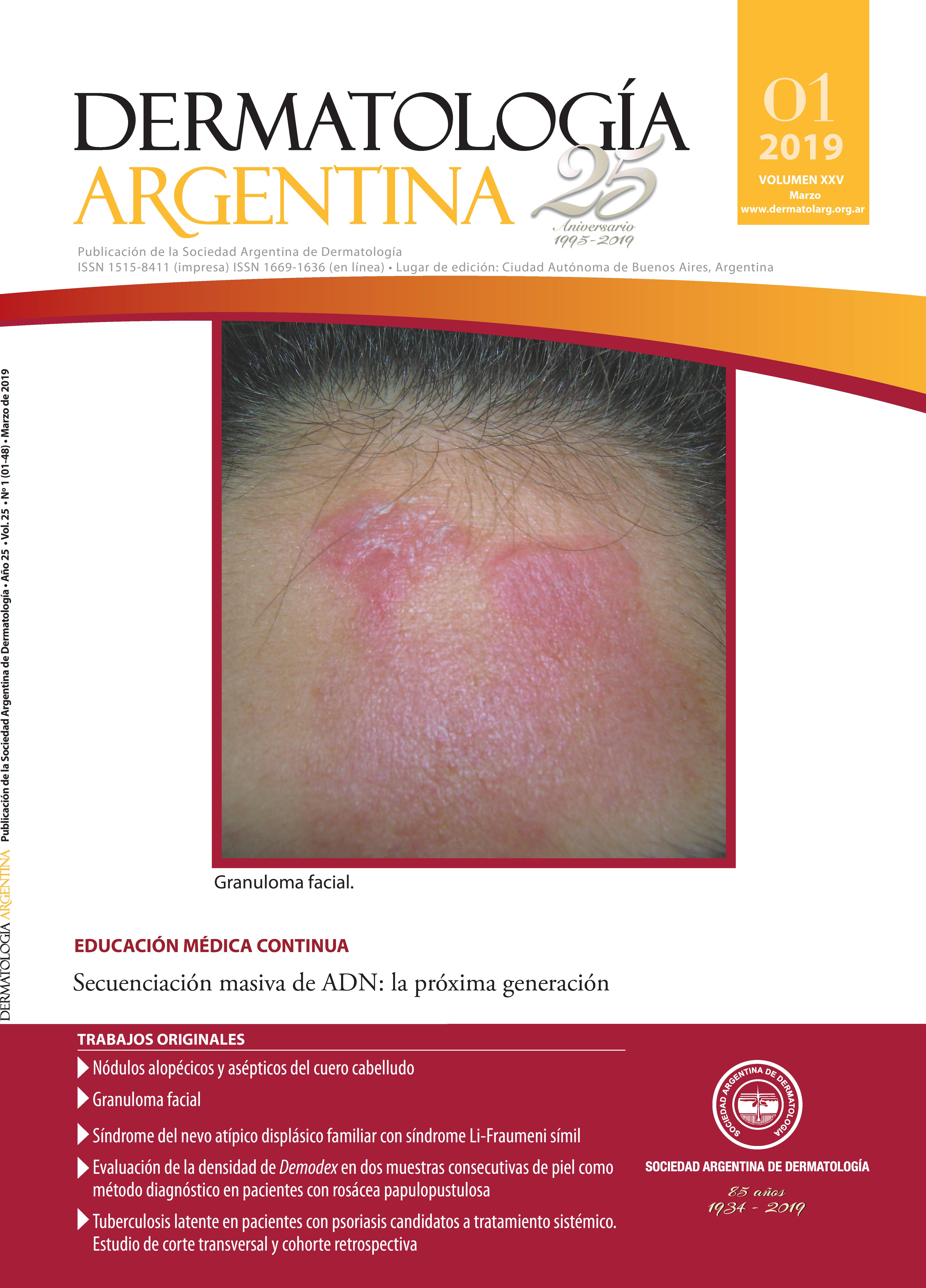Latent tuberculosis in patients with psoriasis candidates for systemic treatment. Cross-sectional study and retrospective cohort
Keywords:
psoriasis, latent tuberculosisAbstract
Background: currently, the use of biological therapies for patients with moderate to severe psoriasis is growing, because of their greater efficacy and lower adverse effects rate. Guidelines for the management of these patients emphasize the obligation to rule out an active and latent tuberculosis (TB) infection before prescription.
Objective: describe the prevalence and incidence of latent tuberculosis in patients with moderate to severe psoriasis under systemic treatment, evaluated at the Psoriasis Unit of the Hospital Universitario Austral from January 2012 to August 2018.
Design: descriptive, cross-sectional study and retrospective cohort. The data were obtained from the database of patients with psoriasis of the Hospital Psoriasis Unit. All patients with psoriasis diagnose under systemic treatment and PPD testing were included. The qualitative variables, nominal and ordinal, were analyzed using percentages. Continuous numerical quantitative variables were analyzed using means and standard deviations. Both prevalence and incidence were reported as proportion with 95% CI (confidence interval).
Results: ninety three patients met the inclusion criteria. The predominant clinical form was plaque psoriasis 80% (74) and 61% (45) presented severe psoriasis. The prevalence of latent tuberculosis was 16% (95% CI 8.5-23.4). The incidence rate was 5% per year (95% CI 2.42-7.18).
Conclusions: the search for underlying TB infection is mandatory, especially in Argentina, where it is still a public health problem.
References
I. Christophers E. Psoriasis: epidemiology and clinical spectrum. Clin Exp Dermatol 2001;26:314-320.
II. Gudjonsson JE, Elder JT. Psoriasis. En: Fitzpatrick. Dermatología en Medicina General. 8.a ed. Editorial Médica Panamericana, Madrid, 2014;18:197-231.
III. Mariette X, Vencovsky J, Lortholary O, Gómez R, et ál. The incidence of tuberculosis in patients treated with certolizumab pegol across indications: impact of baseline skin test results, more stringent screening criteria and geographic region. [En línea]. RMD Open, 28 de abril de 2015;1(1):e000044. [consultado agosto 2018]. doi:10.1136/rmdopen-2014-000044.
IV. Bossio JC, Fernández H, Gómez L, Mordini N, et ál. Boletín epidemiológico de tuberculosis en Argentina. Ministerio Nacional de Salud 2018;1:1-45.
V. Parsons PE, Beck J, Celedón JC, Schnapp LM, et ál. Targeted tuberculin testing and treatment of latent tuberculosis infection. Am J Respir Crit Care Med 2000;161:221-247.
VI. Arias Guillén M, Sánchez Menéndez MM, Alperi M, Riestra S, et ál. High rates of tuberculin skin test positivity due to methotrexate therapy: False positive results. Semin Arthritis Rheum 2018;48:538-546.
VII. Vadillo Font C, Hernández García C, Pato E, Morado IC, et ál. Incidence and characteristics of tuberculosis in patients with autoimmune rheumatic diseases. Rev Clin Esp 2003;203:178-182.
VIII. Wallis RS, Broder MS, Wong JY, Hanson ME, et ál. Granulomatous infectious diseases associated with tumor necrosis factor antagonists. Clin Infect Dis 2004;38:1261-1265.
IX. Calvo Bonachera J, Bernal Rosique MS. Tuberculosis. Diagnóstico y tratamiento. Rev NeumoSur 2012;43:487-497.
X. Rodríguez Jiménez P, Viladrich I, Chicharro P, Solano López G, et ál. Consenso multidisciplinar sobre prevención y tratamiento de la tuberculosis en pacientes candidatos a tratamiento biológico. Adaptación al paciente dermatológico. [En línea]. Actas Dermosifiliogr, 19 de marzo de 2018. [Consultado julio 2018]. https://doi.org/10.1016/j.ad.2018.03.013.
XI. Kammüller M, Griffiths CE, Kapoor N, Brees D, et ál. Inhibition of IL-17 A by secukinumab treatment shows no evidence of increased Mycobacterium tuberculosis infections. Clin Transl Immunology 2017;25: 6-11.
XII. Ponce de León D, Acevedo Vázquez E, Sánchez Torres A, Cucho M, et ál. Attenuated response to purified protein derivative in patients with rheumatoid arthritis: study in a population with a high prevalence of tuberculosis. Ann Rheum Dis 2005;64:1360-1361.
XIII. Laffitte E, Janssens JP, Roux-Lombard P, Thielen AM, et ál. Tuberculosis screening in patients with psoriasis before antitumor necrosis factor therapy: comparison of an interferon-gamma assay vs tuberculin skin test. Br J Dermatol 2009;161:797–800.
Downloads
Published
Issue
Section
License
El/los autor/es tranfieren todos los derechos de autor del manuscrito arriba mencionado a Dermatología Argentina en el caso de que el trabajo sea publicado. El/los autor/es declaran que el artículo es original, que no infringe ningún derecho de propiedad intelectual u otros derechos de terceros, que no se encuentra bajo consideración de otra revista y que no ha sido previamente publicado.
Le solicitamos haga click aquí para imprimir, firmar y enviar por correo postal la transferencia de los derechos de autor











